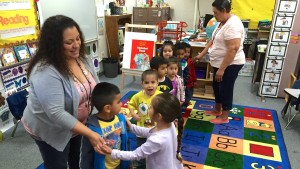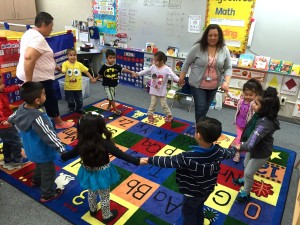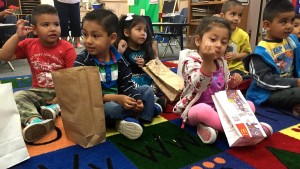TWIN FALLS – Preschool teacher Myra Oesterlein promises her young students life doesn’t have to be defined by hoeing beets and picking crops from sunrise to sunset.

Oesterlein teaches preschool inside Twin Falls’ Oregon Trail Elementary, a special program for the district’s population of migrant workers who labor in the agriculture and dairy industries.
Twin Falls receives federal Title I and Title III funding to support the program, and students must qualify based on their migrant status and their families’ employment.
Many of the students live with their families at El Milagro Migrant Worker Housing, and there are about 270 migrant students attending the district.
Between a morning and afternoon session, the migrant preschool serves 28 students from America, Mexico and Peru – many of whom didn’t speak English on the first day or know anything besides following the harvest and the seasons in search of work.
The first job for Oesterlein – Mrs. O to her children – is to get them ready for school in the most basic of senses.
- Offering a nutritious breakfast for students who may not otherwise receive one.
- Wiping noses and covering coughs.
- Showing that hands are for hugging, not hitting.
- Teaching the virtues of sitting quietly, listening or lining up.
- Sharing and taking turns.
“We don’t want a child to miss class time and have be sent to the office because they didn’t know they are not supposed to do that,” said Oesterlein, who has taught in Idaho, Germany and California. “The social-emotional development skills are very important, as well as routines and schedules.”
But that’s just the beginning.
***
Oesterlein grew up in the fields just like them. She traveled back and forth from Mexico to Idaho, and then Washington and Indiana with her family. With her four brothers and two sisters, the family would toil in the fields or beet dumps in Buhl, Bell Rapids or Filer from 6 a.m. to 6 p.m.
“I know what it’s like to drop everything (when you follow the harvest),” Oesterlein said. “You can’t take everything with you, so many family members can only take necessities. It might not seem like a lot, but when a child leaves friends, toys or a favorite stuffed animal, it can be devastating.
“I can relate to what’s going on in their lives, and that’s why they have a special place in my heart.”
 Oesterlein’s message is simple: Education is the easiest pathway out of the fields or factories.
Oesterlein’s message is simple: Education is the easiest pathway out of the fields or factories.
Oesterlein hated field work, and she tells students that if she found a way out, anybody can.
“I want them to see that I went to college,” she said. “It doesn’t matter if your parents didn’t or if they worked down in the fields all their lives. You can go to school and be anything. If they want to stay in the field, that’s perfect, but if not, there are chances to go.”
***
At the beginning of each year, Oesterlein delivers lessons in a 50/50 mix of Spanish and English to meet the students where they are. As students progress, she adapts lessons so that 60 percent, 70 percent, 80 percent and, finally 90 percent of the instruction is in English by the end of the year. (A surprising side benefit: the two non Spanish-speaking children in the program became bilingual within months, communicating with their classmates in Spanish).
Her immediate goal is to prepare the students to enter kindergarten and progress at grade level or better, especially in reading. So Oesterlein focuses on the alphabet, numbers, letters, senses, how to hold a pencil and why it is important to understand the meaning of greater than, equal to or less than.
Students sing the days of the week, while clapping their hands, then look at pictures of frogs or baby chicks so they can tell Oesterlein which one is green and which ones are yellow.
Oesterlein receives help in the classroom from a part-time paraprofessional and her own mother, Noelia Garza, who signed up for the grandparents program and as a school volunteer to help offset funding cuts for classroom aides.
Last week, they focused on the five senses, using stimuli hidden inside of paper bags that a room full of 3-year-olds explored through smelling, touching, hearing, seeing or tasting.

A boy named Jasiel wrinkled up his face and stuck out his tongue when Oesterlein asked him to imagine how a pipe cleaner tasted.
A few minutes later, Jasiel grabbed a magic wand with a pointy finger attached to the end of it to help Oesterlein call on students who were sitting quietly.
As he waited for someone to quietly raise a hand, Jasiel spontaneously began to dance, twisting his hips from side to side and shifting his weight between his feet.
The smile never receded from his face all morning.
***
Regularly, Oesterlein tracks her students through pre- and post-tests and report cards scored on a scale from zero (below level) to three (proficient). She also sends assignments, newsletters and instructions home in English and in Spanish so that parents can understand their child’s education and become more involved.
Students’ initial marks are almost always zeros and ones. But Oesterlein shared new, end-of-year report cards full of threes in a range of areas from social-emotional development to work habits, motor skills, language arts and reading.
That’s her goal: proficiency or better by kindergarten to allow students to progress alongside the rest of students, build up their literacy and, eventually, get into college.
Twin Falls’ migrant preschool program is only a couple of years old, so there is not much data available yet. Additionally, a few of the students who entered last year as 3-year-olds stayed in the program this year as 4-year-olds because they are still to young for kindergarten.
Even without long-term data, Oesterlein and the district’s migrant coordinator, Abby Montano, are big believers.
Oesterlein uses a laundry metaphor — if you don’t address issues proactively, they will pile up and be that much more difficult later on.
“We have a huge migrant community, and kids by the time they are in high school end up dropping out, or they are struggling in school or hate it,” she said. “This really gives them a head start, and lets the parents learn how important education is and how to work with the children at home.”
“A child’s first years are the most important, pre-K, through third grade,” she continued. “If we can catch them during that time, their success rates will be much higher for graduation rates and continuing on to higher education as well.”
Montano agrees.
“The biggest thing is getting them ready for kindergarten,” Montano said. “All the kindergarten teachers want them (in their classes) because they know they are already ahead.”
